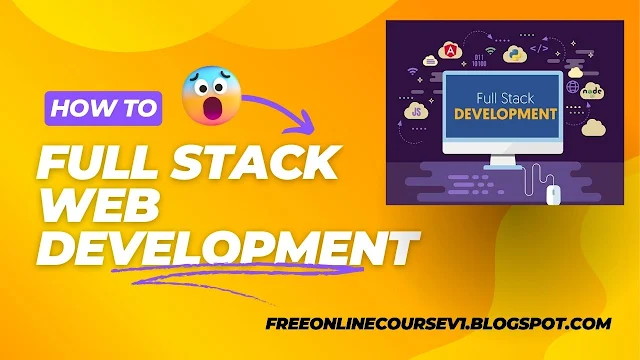Full-stack web development involves working on both the front-end (client-side) and back-end (server-side) aspects of web applications. Here's a step-by-step guide on how to get started with full-stack web development:
1. Learn the Basics:
- HTML/CSS: Understand the structure and presentation of web pages.
- JavaScript: Learn the programming language for front-end development.
2. Front-End Development:
- Framework/Library: Learn a front-end framework/library like React, Angular, or Vue.js.
- Responsive Design: Understand how to create responsive and mobile-friendly user interfaces.
- AJAX and Fetch API: Learn how to make asynchronous requests to the server for data.
3. Back-End Development:
- Choose a Language: Pick a server-side language such as Node.js (JavaScript), Python (Django or Flask), Ruby (Ruby on Rails), Java (Spring), or PHP.
- Database: Learn about databases (e.g., MySQL, PostgreSQL, MongoDB) and how to interact with them.
4. Server and Deployment:
- Server Environment: Set up a server environment. Common choices include Express.js for Node.js, Django for Python, or Ruby on Rails.
- Version Control: Learn a version control system like Git.
- Deployment: Understand how to deploy your application to a server. Platforms like Heroku, AWS, or DigitalOcean are popular choices.
5. Database Management:
- ORM/ODM: Learn an Object-Relational Mapping (ORM) or Object-Document Mapping (ODM) tool to interact with databases more easily.
- Normalization and Indexing: Understand database concepts such as normalization and indexing.
6. APIs (Application Programming Interfaces):
- RESTful APIs: Learn how to create and consume RESTful APIs.
- GraphQL: Explore GraphQL as an alternative API technology.
7. Authentication and Authorization:
- User Authentication: Implement user authentication using techniques like JWT (JSON Web Tokens) or OAuth.
- Authorization: Set up role-based access control.
8. Testing:
- Unit Testing: Write tests for individual components of your application.
- Integration Testing: Test the interactions between different parts of your application.
9. Security:
- HTTPS: Ensure secure communication over the network using HTTPS.
- Input Validation: Protect your application from common security vulnerabilities.
10. DevOps:
- Continuous Integration/Continuous Deployment (CI/CD): Set up CI/CD pipelines to automate the testing and deployment process.
- Containerization: Learn about containerization with Docker.
11. Keep Learning:
- Stay Updated: The field of web development evolves rapidly. Keep learning about new tools, libraries, and best practices.
12. Build Projects:
- Apply What You Learn: Build real projects to reinforce your skills.
- Portfolio: Create a portfolio showcasing your projects and skills.
13. Networking:
- Connect with the Community: Join web development communities, attend meetups, and participate in forums.
14. Soft Skills:
- Communication: Develop good communication skills as you may need to work with cross-functional teams.
15. Specialize (Optional):
- Choose a Niche: Consider specializing in a specific area, such as mobile development, e-commerce, or real-time applications.
HERE VIDEO TUTORIALS/COURSE: https://teraboxapp.com/s/1wyBAQYfSgHKUtvpJYkRqrQ
Remember, full-stack development is a broad field, and the technologies and tools you choose may depend on your personal preferences, project requirements, and industry trends. Stay curious and keep building!

